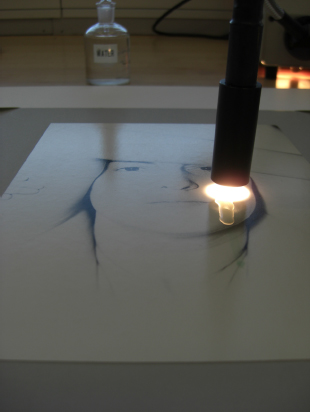
Topics in Photographic Preservation 2009, Volume 13, Article 26 (pp. 198-199)
Presented at the 2009 PMG Winter Meeting in Tucson, Arizona
Occasionally challenging problems require innovative treatments. Sometimes objects are deemed “unexhibitable” due to condition problems that are perceived to be too difficult. The Getty Museum has a small group of photographic materials that fall into this category.
A portrait of “Eleanor”, a triptych, in the Museum’s collection by Harry Callahan is one of these unfortunate examples. The Museum was planning to display a selection of the collection’s great portraits in February 2009 and Callahan’s work was under consideration. The curator noted that a green stain located in the center print of the triptych was very disfiguring and she asked what could be done, if anything, to improve the print. After consulting the conservation records for the museum and reviewing the current condition of the print, we resolved to attempt a treatment. Recent research on the efficacy of light bleaching on gelatin silver prints overall has revealed that light bleaching can produce excellent results for some gelatin silver prints. Methods for local light bleaching for fine art on paper have proven successful under certain conditions.
The problem: The green stain. It appeared to be permanent, possibly a spot toner. The stain penetrated the gelatin emulsion layer and created a disfiguring mark in the center of the image. Solubility tests on the stain were all negative, that is, nothing seemed able to move or lighten it. The surface of the print and the mount did not react to the application of moisture or solvents during testing. We considered what the risks would be for chemical bleaching and light bleaching. The print is mounted to a signed illustration board, which is Callahan’s original presentation. We felt that this aspect of the artist’s intention should be preserved. We then considered how we could treat the stain without removing the print from the mount. Successful tests with light bleaching led to the treatment and local reduction of the stain.
The treatment process: The object was placed flat on the worktable and the lamp was adjusted so that the illumination was directed over the stain area. Small beads of de-ionized water were applied to the area of the stain locally with a Winsor Newton Series 7 sable brush. The lamp provided a small area of light with a soft edge. This helped to prevent the appearance of bleach borders and eliminated the need for masking templates. The lamp was approximately 1cm away from the surface of the print. The lamp intensity was raised to the highest level and care was taken to be sure that the fan was running continuously during the exposure time. The lamp partner to the fiber optic extension was directed away from the print during exposure.
The stain was exposed for approximately four hours, with close monitoring, and rewetting whenever the area appeared dry. Care was taken to avoid possible darkening of the exposed area during treatment. The stain was not completely eliminated, but reduced sufficiently to allow the viewer to enjoy the portrait.
Materials: We used a McBain Instruments Fiber Optic unit with a 250-watt Eiko quartz halogen projector lamp. The ultraviolet radiation and lamp intensity at the end of the fiber optic tube was measured with an Elsec 764 light meter and readings ranged from 45-53 microwatts per lumen at full lamp intensity.
Light bleaching as a treatment option must be carefully considered by the conservator. As a result of the treatment the portrait of “Eleanor” was displayed as a centerpiece of the exhibition. The print will be monitored in the future for changes in the stained area.
Other materials have been treated with this set-up, also with good results. The suitability of the treatment for any particular object is dependent upon the ability to control wetting and avoiding possible water staining.

Topics in Photographic Preservation, Volume Thirteen have not undergone a formal process of peer review.